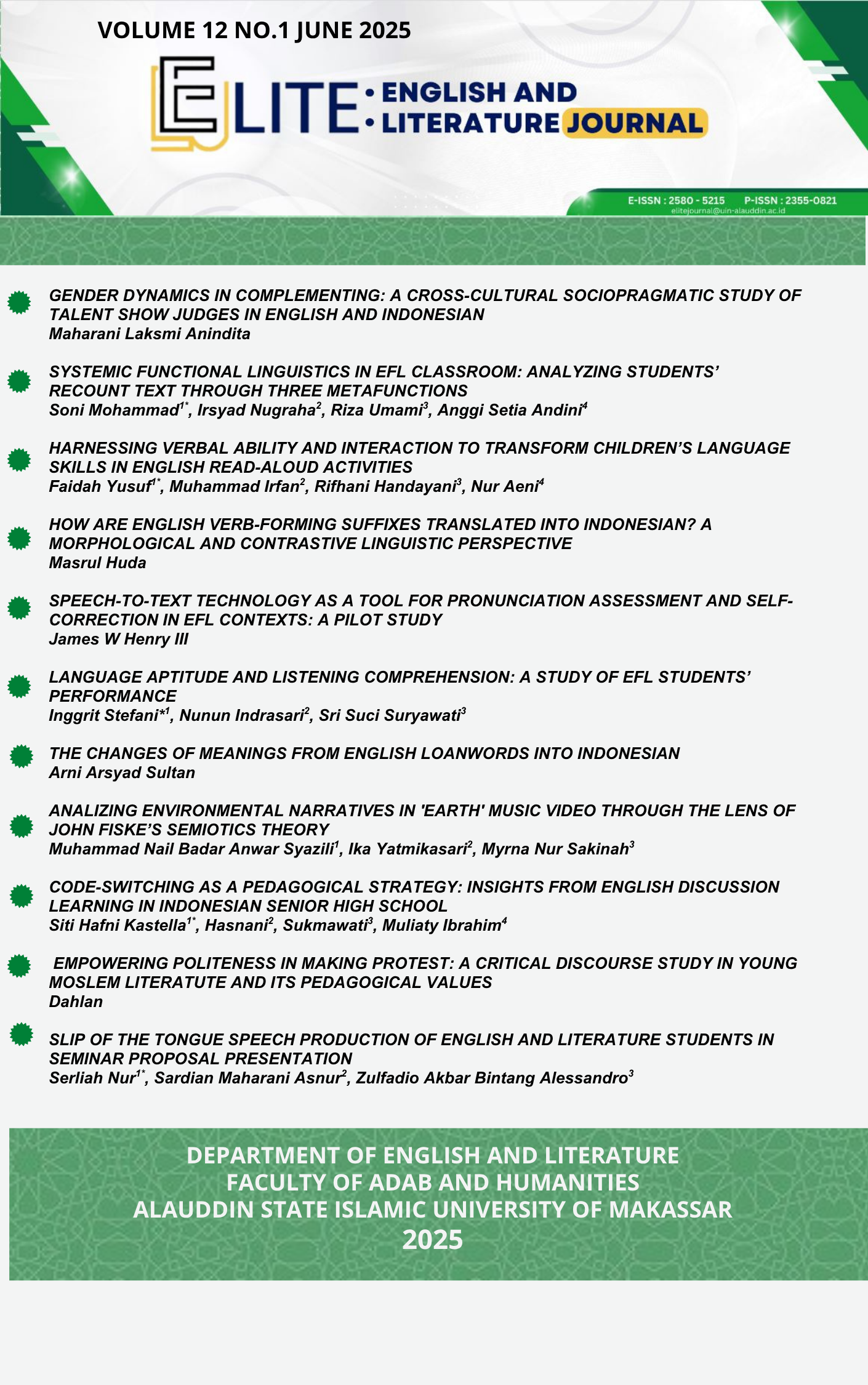SLIP OF THE TONGUE SPEECH PRODUCTION OF ENGLISH AND LITERATURE STUDENTS IN PRESENTATION (CASE STUDY IN PROPOSAL SEMINAR EXAMINATION)
Keywords:
Cognitive load , Proposal Seminar, Slip of the ToungeAbstract
This study aimed to examine the various types of slips of the tongue produced by students of the English and Literature Department at the State Islamic University of Alauddin Makassar during seminar proposal presentations. It also sought to explore the underlying factors contributing to the occurrence of these speech errors. Using a qualitative descriptive approach, data were collected from five participants through audio recordings and follow-up interviews. The findings revealed six types of slips of the tongue based on Fromkin’s (1973) classification: anticipation, exchange, addition, perseveration, substitution, and deletion, with addition being the most frequent. Interview results indicated that cognitive load was the main contributing factor, categorized into intrinsic, extraneous, and germane cognitive load. These findings suggest that slips of the tongue are closely linked to the cognitive demands students face during formal academic speaking tasks.
Downloads
References
Dian Nuswantoro University; Malang.
Ary, D., Jacobs, L. C., & Sorensen, C. (2010). Introduction to research in education. 8th edition. Wadsworth: Cengage Learning.
Astofi, (2016). Slip of the Tongue Produced by Prabowo’s Witnesses in the Constitutional Court. Airlangga University; Surabaya.
Bock, K. (1982). Toward a Cognitive Psychology of Syntax: Information Processing Contributions to Sentence Formulation. Academic Press.
Bogan, R.C., Biklen. (1982). Qualitative Research for Education: Animation to Theory and Method. Allyn and Bacon. Inc; Boston.
Carroll, D. W. (2008). Psychology of Language (Fifth Edition), USA: Thomson Higher Education.
Clark, H. H. (1996). Using language. Cambridge: Cambridge University Press.
Clark, H. H., & Clark, Eve. V. (1977). Psychology and Language (An Introduction to Psycholinguistics).
Core. Language Production. https://core.ac.uk/download/pdf/210661528.pdf.
Accessed on 22nd June 2022.
Creswell, J. W. (2012). Educational Research Planning, Conducting, and Evaluation Quantitative and Qualitative Research (Fourth Edition).
Cribb, Michael. 2021. Speech Error (definition). https://neutralfooting.wordpress.com/glossary/speech-error-definition/.
Accessed on 22nd June 2022.
Doromae, Arsiayah. (2018). The Problem Faced by Thai Students in Speaking English Skill at University of Muhammadiyah Malang. University of Muhammadiya Malang. Malang
Dr. Rohmani Nur Indah, M. P. (2018). TEORI-TEORI PSIKOLINGUISTIK.
Effendi, R.W dan Tjahjono, E. 1999. Hubungan Antara Perilaku Coping dan Dukungan Sosial dengan Kecemasan pada Ibu Hamil Anak Pertama. Anima. Vol.14, no.54, h. 215-221.
Field, J. (2004). Psycholinguistics: the key concepts. In System (Vol. 33, Issue 1). https://doi.org/10.1016/j.system.2004.12.005. Accessed on 16th November 2023
Freud, S. (1901). Psychopathology of Everyday Life. The Journal of Nervous and Mental Disease, 42(9), 655. https://doi.org/10.1097/00005053-191509000-
00012. Accessed on 16th November 2023
Fromkin, V. A. (1973). Speech Errors as Linguistics Evidence. The Hague; Mountoun Publisher.
Garret, M.F. (1980). The Analysis of Sentence Production. Lawrence Erlbaum Associates, Inc.
Giegerich, Heinz J. (1992). English Phonology: An introduction. Cambridge University Press: Cambridge.
Goldstein et all. (2007). Dinamic Action Units Slip in Speech Production Errors.
University of Endiburgh; UK.
Harastasya, Anggun., Dadang Sudana., Ruswan Dallyono (2020). Investigating the Types and Causes of Slips of The Tongue of One of The Indonesia Female Singers. English and Literature. Universitas Pendidikan Indonesia. https://ejournal.upi.edu/index.php/psg/article/download/29841/pdf
Indah, Rohmani Nur. (2004). Language Production and Speech Error. UIN Malang; Malang.
Jalil, Linda Rochmana Putri Wardani. (2017). An Analysis of Dictongloss Technique to Teach Writing at the Eighth Grade of SMPN 1 Kemlagi Mojokerto. University of Muhammadiya Malang. Malang.
Lazarus, R. (1976). Pattern of Adjusment. Third Edition. McGraw-Hill; New York. Maisaroh, Nur Ekka, and Falasifatul Falah (2011). Religiusitas dan Kecemasan Menghadapi Ujian Nasional (Un) Pada Siswa Madrasah Aliyah. Universitas
Islam Sultan Agung Semarang. Semarang.
Matthew J. Traxler. (2012). Introduction to Psycholinguistics, Understanding Language Science. Wiley-Blackwell; New Jersey.
Mayasari, Ira. (2015). Senyapan dan Kilir Lidah dalam Produksi Ujaran (Kajian Psikolinguistik). UIN Alauddin; Makassar.
McCarthy, M. (1990). Vocabulary. Oxford University Press; Oxford.
Miller, P.H. (2011). Theories of Developmental Psychology. 5th edition. Worth Publishers; New York.
Mus, Nurhikmawati. (2018). Analyzing Slip of The Tongue in Classroom Conversation at The Second Semester of English Education Department. UIN Alauddin; Makassar.
Naibaho., Tri Ayu S., Mazrul Aziz., and Barnabas Sembiring. (2019). Slips of the Tongue Made by the English Study Program Students. Journal of English Education and Teaching.
Prameswari, Syafina Diva. (2019). Mengapa Slipf of Tongue Bisa Terjadi? https://www.researchgate.net/publication/331824021_Mengapa_Slip_of_Ton gue_Bisa_Terjadi. Accessed on 5th July 2023
Putri, Claudya Nabillah Riza Putri. (2015). Slips of Tongue of News Anchor.
Maulana Malik Ibrahim State Islamic University of Malang. Malang Riantoby, Laily Hamza Siti Salma. (2014). Slip of The Tongue Produced by
Television News Presenters of KOMPAS TV. Universitas Airlangga; Surabaya Sugiyono. (1992). Metode Penelitian Pendidikan (Pendekatan Kuantitatif,
Kualitatif dan R&D), Alfabeta; Bandung.
Sweller, J., Paul Ayres, and S. K. (2011). Explorations in the Learning Sciences, Instructional Systems and Performance Technologies Series Editors. http://www.springer.com/series/8640
Downloads
Published
How to Cite
Issue
Section
License
Copyright (c) 2025 Serliah Nur, Sardian Maharani Asnur , Zulfadio Akbar Bintang Alessandro

This work is licensed under a Creative Commons Attribution-NonCommercial-ShareAlike 4.0 International License.
Once an article was published in the journal, the author(s) are:
granted to the journal right licensed under Creative Commons License Attribution that allows others to share the work with an acknowledgement of the work's authorship.
permitted to publish their work online in third parties as it can lead wider dissemination of the work.
continue to be the copyright owner and allow the journal to publish the article with the CC BY-NC-SA 4.0 license
receiving a DOI (Digital Object Identifier) of the work.













